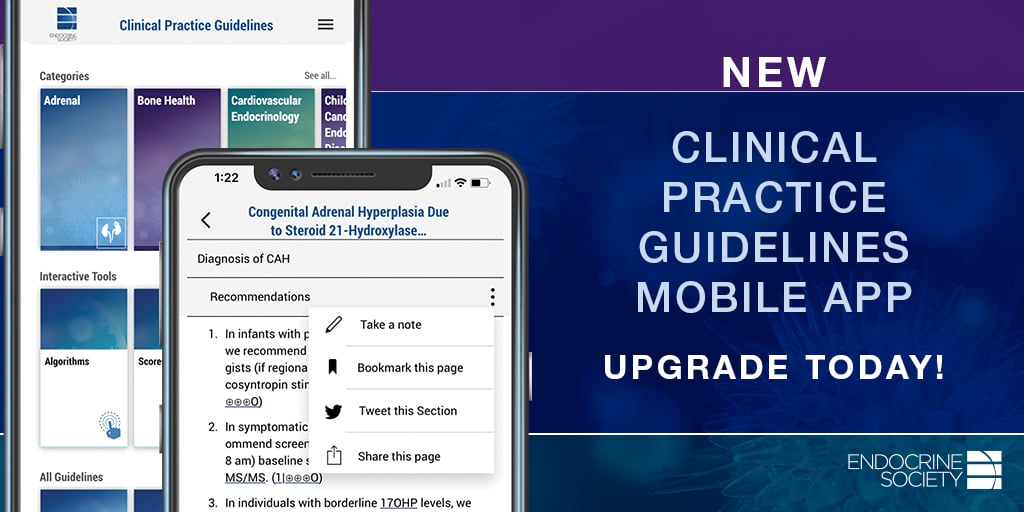Full Guideline: The Diagnosis of Cushing’s Syndrome
JCEM | May 2008
Lynnette K. Nieman (Chair), Beverly M. K. Biller, James W. Findling, John Newell-Price, Martin O. Savage, Paul M. Stewart, Victor M. Montori
Co-Sponsoring Organization: European Society of Endocrinology
The 2008 guideline on the diagnosis of Cushing’s Syndrome:
- Provides recommendations for the diagnosis of Cushing’s Syndrome
- Emphasizes early recognition of Cushing’s Syndrome to reduce the risk of residual morbidity
Essential Points
- The most common cause of Cushing’s syndrome is iatrogenic from medically prescribed corticosteroids.
- Excess cortisol production may be caused by either excess adrenocorticotropic hormone (ACTH) secretion (from a pituitary or other ectopic tumor) or independent adrenal overproduction of cortisol.
- The diagnosis can be challenging in mild cases:
- Endocrine Society (ES) recommends initial use of one test with high diagnostic accuracy (urine free cortisol [UFC], late night salivary cortisol, 1-mg overnight or 2-mg 48-h dexamethasone suppression test).
- Testing for Cushing’s syndrome in certain high-risk populations has shown an unexpectedly high incidence of unrecognized Cushing’s syndrome as compared with the general population. Although there are limited data on the prevalence of the syndrome in these disorders, the diagnosis should be considered.
- Often patients have a number of features that are caused by cortisol excess but that are also common in the general population such as obesity, depression, diabetes, hypertension, or menstrual irregularity.
- As a result, there is an overlap in the clinical presentation of individuals with and without the disorder. The distinction between these groups is difficult, and there is no one correct diagnostic strategy.
- There is a wide spectrum of clinical manifestations at any given level of hypercortisolism. Because Cushing’s syndrome tends to progress, accumulation of new features increases the probability that the syndrome is present.
- Caregivers are encouraged to consider Cushing’s syndrome as a secondary cause of these conditions, particularly if additional features of the disorder are present. If Cushing’s syndrome is not considered, the diagnosis is all too often delayed.
Summary of Recommendations
+ 3.0 Diagnosis of Cushing's syndrome
Who should be tested
- 3.1 We recommend obtaining a thorough drug history to exclude excessive exogenous glucocorticoid exposure leading to iatrogenic Cushing’s syndrome before conducting biochemical testing. (1|⊕⊕⊕⊕)
- 3.2 We recommend testing for Cushing’s syndrome in the following groups:
- Patients with unusual features for age (e.g. osteoporosis, hypertension) (Table 1) (1|⊕⊕⚪⚪)
- Patients with multiple and progressive features, particularly those who are more predictive of Cushing’s syndrome (Table 1) (1|⊕⊕⚪⚪)
- Children with decreasing height percentile and increasing weight (1|⊕⚪⚪⚪)
- Patients with adrenal incidentaloma compatible with adenoma (1|⊕⚪⚪⚪)
- 3.3 We recommend against widespread testing for Cushing’s syndrome in any other patient group. (1|⊕⚪⚪⚪)
Initial testing
- 3.4 For the initial testing for Cushing’s syndrome, we recommend one of the following tests based on its suitability for a given patient (Fig. 1) (1|⊕⚪⚪⚪):
- 3.4.1 Urine free cortisol (UFC; at least two measurements)
- 3.4.2 Late-night salivary cortisol (two measurements)
- 3.4.3 1-mg overnight dexamethasone suppression test (DST)
- 3.4.4 Longer low-dose DST (2| mg/d for 48 h)
- 3.5 We recommend against the use of the following to test for Cushing’s syndrome (1|⊕⚪⚪⚪):
- Random serum cortisol or plasma ACTH levels
- Urinary 17-ketosteroids
- Insulin tolerance test
- Loperamide test
- Tests designed to determine the cause of Cushing’s syndrome (e.g., pituitary and adrenal imaging, 8 mg DST)
- 3.6 In individuals with normal test results in whom the pretest probability is high (patients with clinical features suggestive of Cushing’s syndrome and adrenal incidentaloma or suspected cyclic hypercortisolism), we recommend further evaluation by an endocrinologist to confirm or exclude the diagnosis. (1|⊕⚪⚪⚪)
- 3.7 In other individuals with normal test results (in whom Cushing’s syndrome is very unlikely), we suggest reevaluation in 6 months if signs or symptoms progress. (2|⊕⚪⚪⚪)
- 3.8 In individuals with at least one abnormal test result (for whom the results could be falsely positive or indicate Cushing’s syndrome), we recommend further evaluation by an endocrinologist to confirm or exclude the diagnosis. (1|⊕⚪⚪⚪)
Subsequent evaluation
- 3.9 For the subsequent evaluation of abnormal initial test results, we recommend performing another recommended test (Fig. 1). (1|⊕⚪⚪⚪)
- 3.9.1 We suggest the additional use of the dexamethasone-CRH test or the midnight serum cortisol test in specific situations (Fig. 1). (1|⊕⚪⚪⚪)
- 3.9.2 We suggest against the use of the desmopressin test, except in research studies, until additional data validate its utility. (2|⊕⚪⚪⚪)
- 3.9.3 We recommend against any further testing for Cushing’s syndrome in individuals with concordantly negative results on two different tests (except in patients suspected of having the very rare case of cyclical disease). (1|⊕⚪⚪⚪)
- 3.9.4 We recommend tests to establish the cause of Cushing’s syndrome in patients with concordantly positive results from two different tests, provided there is no concern regarding possible non-Cushing’s hypercortisolism (Table 2). (1|⊕⊕⚪⚪)
- 3.9.5 We suggest further evaluation and follow-up for the few patients with concordantly negative results who are suspected of having cyclical disease and also for patients with discordant results, especially if the pretest probability of Cushing’s syndrome is high. (2|⊕⚪⚪⚪)
+ 4.0 Special populations/considerations
- 4.1 Pregnancy: We recommend the use of UFC and against the use of dexamethasone testing in the initial evaluation of pregnant women. (1|⊕⊕⊕⚪)
- 4.2 Epilepsy: We recommend against the use of dexamethasone testing in patients receiving antiepileptic drugs known to enhance dexamethasone clearance and recommend instead measurements of nonsuppressed cortisol in blood, saliva, or urine. (1|⊕⊕⊕⚪)
- 4.3 Renal failure: We suggest using the 1-mg over-night DST rather than UFC for initial testing for Cushing’s syndrome in patients with severe renal failure. (2|⊕⚪⚪⚪)
- 4.4 Cyclic Cushing’s syndrome: We suggest use of UFC or mid-night salivary cortisol tests rather than DSTs in patients suspected of having cyclic Cushing’s syndrome. (2|⊕⚪⚪⚪)
- 4.5 Adrenal incidentaloma: We suggest use of the 1-mg DST or late-night cortisol test, rather than UFC, in patients suspected of having mild Cushing’s syndrome. (2|⊕⊕⚪⚪)

